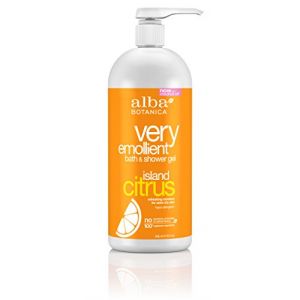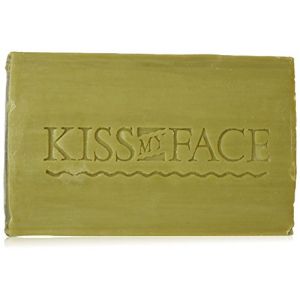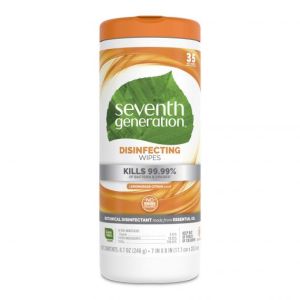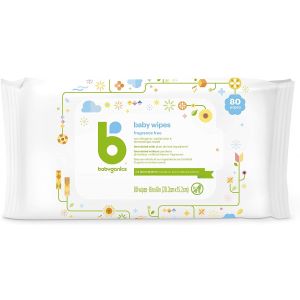- Pros:
- Biodegradable, pure, and highly concentrated castile soap for hair and whole body cleansing
- Good for sensitive skin
- Produces a rich, emollient lather and a moisturizing after feel 18-in-1 uses
- For rinsing food, mopping, doing laundry, cleaning dishes, and more
- Purest organic and fair trade ingredients
- Packaged in 100% post-consumer recycled plastic and paper
- Fair Trade and OTCO certified
- Non-GMO certified
- Several ingredients are certified organic by the USDA National Organic Program and certified vegan Cruelty-free
- Free of preservatives, detergents, foaming agents, artificial fragrances
Ingredients Concern: None
Cons: Not flushable
Does not contain any ingredients to kill bacteria which it has a very safe ingredient list
You have probably seen the Dr Bronner's soaps brand at Whole Foods or at a local health store, but you probably didn't know the amazing story behind the brand. Dr. Bronner company was founded in 1948 by Emanuel Bronner, a third- generation master soapmaker from a German-Jewish soapmaking family. He continued soapmaking in Germany during the war until the Nazis took over, nationalized his family soap factory and then sent his parents to Auschwitz where they died. Dr Bronner eventually went to a mental institution and received shock treatments. He later escaped and went to the USA, where his clean ingredient brand became iconic in the 1960s by using global unity messages on his soaps like We are All One or None! Today, the company is still family-owned and run, and they continue to make socially & environmentally responsible products of the highest quality, and give some of their profits to great charitable causes. Dr Bronner's products have organic and fair trade ingredients, most of which are vegan and certified to the same organic standards as food. There are no synthetic preservatives or foaming agents. Dr Bronne's children run the company and sell products for the body, hair, face, mouth, teeth, food, dishes, laundry, mopping and pets. This company uses 100% post-consumer recycled plastic packaging bottle-to-bottle recycling
Olive oil is a rich source of monounsaturated fats (about 73%), followed by saturated fat (about 14%), and polyunsaturated fat (11%) [1-4]. Monounsaturated fats in olive oil enhance overall health [1-4]. Olive oil contains vitamins E, K, and an ample amount of antioxidants; it improves the body's utilization of vitamins A, D and K as well [5, 6]. All of these vitamins and nutrients help nourish the skin and hair. It also has anti-inflammatory properties that can help improve the health of the skin, including the scalp [7, 8]. Olive oil appears to have protective properties against blood sugar problems and it has anti-bacterial properties as well that help support liver function, bile production and removal, and intestinal function [11, 12]; all of which can improve the appearance of the skin. Olive oil has also demonstrated skin protective and anti-aging properties [13-17].
Coconut oil has been shown to promote skin and hair health due to its moisturizing properties [18, 19].
Hemp, which is also known as cannabis, is frequently used in dietary supplements, clothing, cosmetics, and medicines due to its soothing and relaxing properties [20]. Hemp also targets the excessive buildup of a thick oily substance that the body produces called sebum [20]. Sebum typically contributes to the integrity of the skin's epidermal barrier, but the excess production of sebum lead to acne and scalp inflammation.
Whole body and hair cleansing [1-4, 18, 20]; All-purpose cleaner [20]
Olive oil contains a small percentage of polyunsaturated fat (e.g., omega-6 and omega-3 fatty acids) as well as a large percentage of monounsaturated fat called oleic acid, which helps target inflammation, improves heart health and may also have anti-cancer properties [1-4]. The body cannot produce these types of essential acids on its own.
Olive oil contains vitamins and antioxidants that improve the body's ability to ward off illnesses [5, 6]. These nutrients help boost the health of the skin and hair.
Olive oil contains anti-inflammatory components such as oleocanthal, which help improve the appearance of the skin and can also help target an irritated scalp [7, 8]. In addition, oleic acid in olive oil is a fatty acid that reduces the level of inflammatory proteins such as C-reactive protein (CRP) [9, 10].
Olive oil improves the body's regulation of blood sugar levels and it has been shown to target bacteria such as Helicobacter pylori, which is an important factor for skin health [11, 12]. Furthermore, its components such as hydroxytyrosol, tyrosol, oleocanthal, and oleuropein appear to regulate about 100 human genes that are involved in cell signaling, anti-aging processes [13-17].
Coconut oil supports moisture retention of dry hair, as well as irritated skin, including the scalp, and it helps target skin inflammation [18, 19].
Sebum is an oily (lipid-based) substance that the body naturally produces to support the integrity of the skin's epidermal barrier, but the excess production of sebum lead to acne and scalp inflammation. More specifically, the accumulation of sebum on the scalp leads to thick, dandruff-like layers. Sebum can subsequently clog the pores of the skin and the roots of the scalp, which can subsequently disrupt nutrient transport to the skin, scalp, and hair follicles. Hemp, also known as cannabis, has anti-microbial, anti-inflammatory, anti-lipogenic, and collagen-promoting properties that have been shown to target excess sebum production, thereby indicating that it can help target acne and hair problems [20].
Key Ingredients: Organic coconut oil, Organic olive oil, Organic hemp oil (% were not listed)
All Ingredients: Water, Organic coconut oil, Potassium Hydroxide, Organic Palm kernel oil, Organic olive oil, Organic hemp oil, Organic jojoba oil, Citric acid, Tocopherol
Face: 2-3 drops on wet hands, applied to wet face
Body: one small squirt on a wet washcloth, applied to a wet body
Hair: 1/2 Tbsp. in your hand, worked into wet hair, or dilute 1/2 Tbsp. in 1/2 a cup of water and work that into wet hair
Bath: Completely depends upon water amount, but roughly 2 Tbsp. soap in an average sized tub. (Doesn't bubble, but still cleans)
Shaving: Face - 10 drops; Underarms - 3 drops; Legs - 1/2 tsp; Work to a lather in wet hands and then apply to area.
Teeth: 1 drop on a toothbrush. (Yes, it tastes like soap.)
Foot Bath: 11/2 tsp. in a small tub of hot water.
Clearing Congestion: 1 Tbsp. in a bowl of steamy hot water. Breathe in mist with a towel draped over the head.
Household uses:
Dishes (handwashing): Pre-dilute 1:10 with water. Squirt on a scrub brush and scrub dishes.
Laundry: 1/3-1/2 c. of soap for a large load in a normal washer. Add 1/2 c. vinegar to the rinse cycle. Use half of these amounts for HE.
Mopping: 1/2 c. of soap in 3 gallons of hot water.
All-purpose cleaning: 1/4 c. soap in a quart of water in a spray bottle. Add 1/4 tsp. tea tree essential oil if desired.
These statements have not been evaluated by the FDA. These products are not intended to diagnose, treat, cure or prevent any disease.
1. Wongcharoen W, Jai-Aue S, Phrommintikul A, Nawarawong W, Woragidpoonpol S, Tepsuwan T, Sukonthasarn A, Apaijai N, Chattipakorn N. Effects of curcuminoids on frequency of acute myocardial infarction after coronary artery bypass grafting. Am J Cardiol. 2012;110(1):40-4.
2. Mishra S, Palanivelu K. The effect of curcumin (turmeric) on Alzheimer's disease: An overview. Ann Indian Acad Neurol. 2008;11(1):13-9.
3. Zhang L, Fiala M, Cashman J, Sayre J, Espinosa A, Mahanian M, Zaghi J, Badmaev V, Graves MC, Bernard G, Rosenthal M. Curcuminoids enhance amyloid-beta uptake by macrophages of Alzheimer's disease patients. J Alzheimers Dis. 2006;10(1):1-7.
4. Nagpal M, Sood S. Role of curcumin in systemic and oral health: An overview. J Nat Sci Biol Med. 2013; 4(1): 3–7.
5. Tayyem RF, Heath DD, Al-Delaimy WK, Rock CL. Curcumin content of turmeric and curry powders. Nutr Cancer. 2006;55(2):126-31.
6. Jurenka JS. Anti-inflammatory properties of curcumin, a major constituent of Curcuma longa: a review of preclinical and clinical research. Altern Med Rev. 2009;14(2):141-53.
7. SinghS, Aggarwal BB. Activation of Transcription Factor NF-κB Is Suppressed by Curcumin (Diferuloylmethane). J Bio Chem. 1995; 270:24995-25000.
8. Marín YE, Wall BA, Wang S, Namkoong J, Martino JJ, Suh J, Lee HJ, Rabson AB, Yang CS, Chen S, Ryu JH. Curcumin downregulates the constitutive activity of NF-kappaB and induces apoptosis in novel mouse melanoma cells. Melanoma Res. 2007;17(5):274-83.
9. Chainani-Wu N. Safety and anti-inflammatory activity of curcumin: a component of tumeric (Curcuma longa). J Altern Complement Med. 2003 Feb;9(1):161-8.
10. Goel A, Boland CR, Chauhan DP. Specific inhibition of cyclooxygenase-2 (COX-2) expression by dietary curcumin in HT-29 human colon cancer cells. Cancer Lett. 2001;172(2):111-8.
11. Aggarwal BB, Harikumar KB. Potential therapeutic effects of curcumin, the anti-inflammatory agent, against neurodegenerative, cardiovascular, pulmonary, metabolic, autoimmune and neoplastic diseases. Int J Biochem Cell Biol. 2009;41(1):40-59.
12. Lal B, Kapoor AK, Asthana OP, Agrawal PK, Prasad R, Kumar P, Srimal RC. Efficacy of curcumin in the management of chronic anterior uveitis. Phytother Res. 1999 Jun;13(4):318-22.
13. Takada Y, Bhardwaj A, Potdar P, Aggarwal BB. Nonsteroidal anti-inflammatory agents differ in their ability to suppress NF-kappaB activation, inhibition of expression of cyclooxygenase-2 and cyclin D, and abrogation of tumor cell proliferation. Oncogene. 2004;23(57):9247-58.
14. Menon VP1, Sudheer AR.Antioxidant and anti-inflammatory properties of curcumin. Adv Exp Med Biol. 2007;595:105-25.
15. Barclay LR, Vinqvist MR, Mukai K, Goto H, Hashimoto Y, Tokunaga A, Uno H. On the antioxidant mechanism of curcumin: classical methods are needed to determine antioxidant mechanism and activity. Org Lett. 2000;2(18):2841-3.
16. Agarwal R, Goel SK, Behari JR. Detoxification and antioxidant effects of curcumin in rats experimentally exposed to mercury. J Appl Toxicol. 2010;30(5):457-68.
17. Bulmus FG, Sakn F, Turk G, Sonmez M, Servi K. Protective effects of curcumin on antioxidant status, body weight gain, and reproductive parameters in male rats exposed to subchronic 2,3,7,8-tetrachlorodibenzo-p-dioxin. Tox Envir Chem. 2013; 95(6):1019-1029.
18. Biswas SK, McClure D, Jimenez LA, Megson IL, Rahman I. Curcumin induces glutathione biosynthesis and inhibits NF-kappaB activation and interleukin-8 release in alveolar epithelial cells: mechanism of free radical scavenging activity. Antioxid Redox Signal. 2005;7(1-2):32-41.
19. Aggarwal BB, Kumar A, Bharti AC. Anticancer potential of curcumin: preclinical and clinical studies. Anticancer Res. 2003;23(1A):363-98.
20. Anand P, Sundaram C, Jhurani S, Kunnumakkara AB, Aggarwal BB. Curcumin and cancer: an "old-age" disease with an "age-old" solution. Cancer Lett. 2008;267(1):133-64.
21. Shoba G, Joy D, Joseph T, Majeed M, Rajendran R, Srinivas PS. Influence of piperine on the pharmacokinetics of curcumin in animals and human volunteers. Planta Med. 1998;64(4):353-6.
22. McGuffin M, Hobbs C, Upton R, Goldberg A, eds. American Herbal Products Association's Botanical Safety Handbook. Boca Raton, FL: CRC Press, LLC 1997.
23. Umar S, Golam Sarwar AH, Umar K, Ahmad N, Sajad M, Ahmad S, Katiyar CK, Khan HA. Piperine ameliorates oxidative stress, inflammation and histological outcome in collagen induced arthritis. Cell Immunol. 2013; 284(1-2):51-9.
24. Bano G, Amla V, Raina RK, et al. The effect of piperine on pharmacokinetics of phenytoin in healthy volunteers. Planta Med 1987;53:568-9.
25. Khardwaj RK, Glaeser H, Becquemont L, et al. Piperine, a major constituent of black pepper, inhibits human P-glycoprotein and CYP3A4. J Pharmacol Exp Ther 2002;302:645-50.
26. Prakash UN, Srinivasan K. Gastrointestinal protective effect of dietary spices during ethanol-induced oxidant stress in experimental rats. Appl Physiol Nutr Metab. 2010 Apr;35(2):134-41
27. Diwan V, Poudyal H, Brown L. Piperine attenuates cardiovascular, liver and metabolic changes in high carbohydrate, high fat-fed rats. Cell Biochem Biophys. 2013;67(2):297-304.
28. Shrivastava P, Vaibhav K, Tabassum R, et al. Anti-apoptotic and anti-inflammatory effect of Piperine on 6-OHDA induced Parkinson's rat model. J Nutr Biochem. 2013;24(4):680. 29. Sikora E, Bielak-Zmijewska A, Mosieniak G, Piwocka K. The promise of slow down ageing may come from curcumin. Curr Pharm Des. 2010;16(7):884-92.






